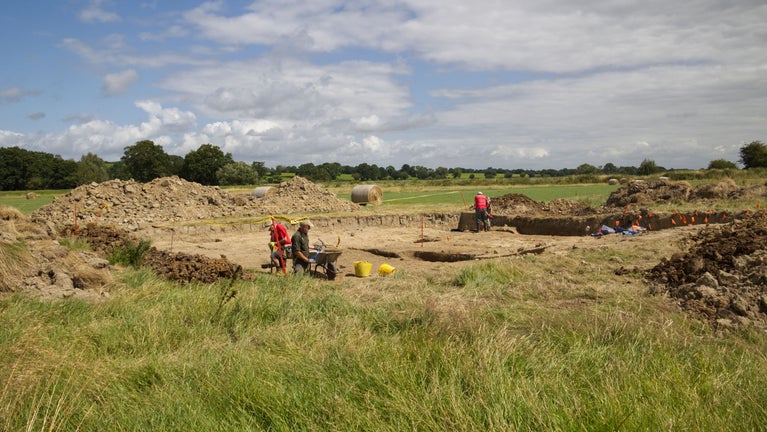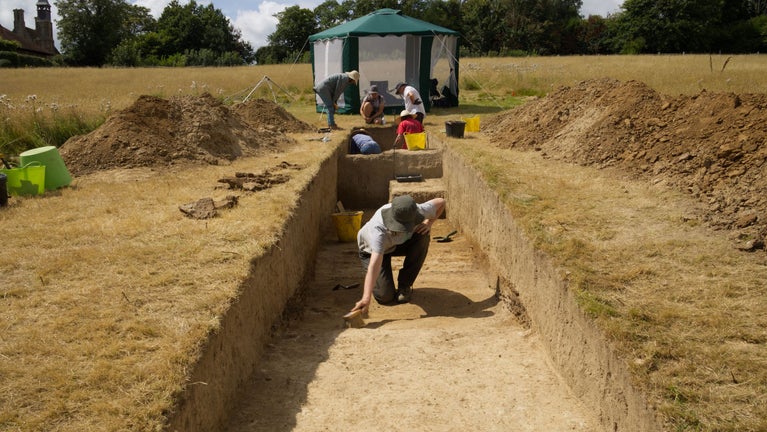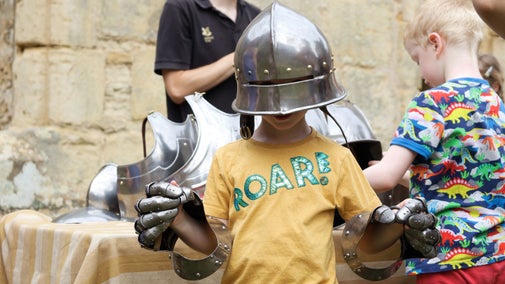Archaeology at Bodiam Castle

‘Bodiam Dig: the road to 100’ is a three-year project to explore the buried archaeology of this iconic site leading up to the 100th anniversary in 2026 of the site being bequeathed to the National Trust.
Visiting Bodiam can be like travelling in time, across a landscape that has been managed and altered by people over thousands of years. In the National Trust collection at Bodiam Castle are items from all periods, such as a Neolithic polished stone axe and a late Iron Age cremation urn, Roman tiles, a medieval pilgrim badge and fragments of pottery and leather, and more recent artefacts like clay pipes and coins, all of which help to tell the tales of those who lived, worked and visited this place.
‘Bodiam Dig: the road to 100’ is a three-year project to explore the buried archaeology of this iconic site leading up to the 100th anniversary in 2026 of the site being bequeathed to the National Trust. While the 14th-century castle forms the central focus of the site, the wider landscape has been less well explored. With this project, we hope to uncover more information about the history of the landscape around the castle, focusing on the potential for Roman activity and of the land management and use of the area close to the River Rother over time.
We are delighted to be partnering with the Institute of Archaeology University College London and Archaeology South-East, with support from the Hastings Area Archaeological Research Group and the Wealden Archaeology Group. We will be digging at Bodiam for three weeks this summer – from late July to mid-August with a team including students from University College London and National Trust volunteers, many of whom have honed their skills over the years working on archaeological projects at Knole and Smallhythe. This year, we will be opening trenches in Doakes Field to the north of the castle, to explore the line of the Roman road that runs through the field and excavating in Freren Mead to the south of the river. We’ve already undertaken geophysical surveys using magnetometry and ground penetrating radar, which have returned some intriguing results and given us some interesting targets to explore.

What's on in Summer 2025
We're gearing up for the second year of digging into the past with UCL and Archaeology South-east. Over three weeks, uncover the castle’s hidden history through tours, expert talks, and more! Events now open for booking:
7, 8, 9, 14, 15, 16, 21 & 22 Aug | 11am–12pm | £8 adult / £4 child
Join National Trust archaeologist Nathalie Cohen as she takes you on a tour of a live archaeological dig. Book now.
Mysteries of Historical Graffiti Tour
Sun 3 Aug | 5.30pm–7pm | £10 per person
Join leading medieval graffiti expert and author Matthew Champion for an after-hours historical graffiti tour around the castle. Book now.
Forgotten Landscapes evening tour at Bodiam Castle
Wed 13 Aug & Sat 16 Aug | 5.30pm to 7pm | £12 per person
Join landscape archaeologist Dr. Al Oswald for a special after-hours guided tour exploring the rich and varied historic traces visible around Bodiam Castle, from prehistory to World War II. Book now.
Summer 2024
During the summer, our team spent three weeks exploring eight trenches to the north and south of Bodiam Castle. We had the privilege of interacting with thousands of curious visitors during this time and the enjoyable experience of camping on-site.
Our discoveries ranged from remains of the 20th-century hop gardens and 19th-century land drainage systems to medieval lynchets, an Iron Age/Roman routeway, and buried prehistoric deposits. While artefacts were few, we made several notable finds including fragments of late Iron Age / Roman ceramics, a nail, and a single sherd of 9th-10th century pottery.
This season provided a wonderful opportunity to evaluate previously unexcavated areas. A huge thank you to our dedicated volunteers, students and colleagues from the Institute of Archaeology UCL, the staff from Archaeology South-East, and the property team for their unwavering support on-site and warm welcome. We were also pleased to be joined by PCSO Daryl Holter, who had a display to educate visitors about heritage crime.
Archaeological Evaluation Report
This report details the results of the archaeological evaluation trial trenching undertaken during the July and August 2024.

A brief history of Bodiam Castle
Discover the history of Bodiam Castle. Find out who built it, its royal connections and what historic graffiti can tell us about the castle’s past.

The grounds of Bodiam Castle
Discover what to see and do in the grounds of Bodiam Castle. Take a riverside walk, stop for a picnic or look for wildlife – from rare bees to bats.

Upcoming events at Bodiam Castle
There’s plenty of things to see and do waiting to be discovered at Bodiam Castle. Step into history and take part in a host of family-friendly events all year round, including a medieval fair, re-enactment groups, activity trails, and more!
